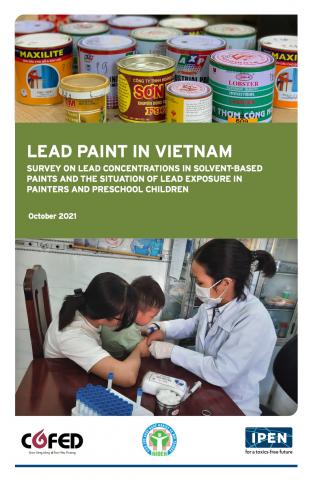Lead Paint in Vietnam

According to the World Health Organization, lead is one of the ten heavy metals that need most attention to human health, especially children. It is estimated that in 2000, around 120 million people worldwide were exposed to lead, of which mainly children, each year an additional 600,000 children were recorded intellectually affected and 143,000 deaths were reported, due to lead exposure, especially in developing countries. Children are at risks of lead poisoning from a variety of sources such as leaded gasoline, leaded paint, toys, mining activities, battery recycling, environmental pollutions, etc. Lead poisoning can cause multiple and complex damages on most organs and systems in the body such as: nervous, circulatory, cardiovascular, skeletal, and urinary. In the world, there have been studies on lead poisoning in children and lead poisoning prevention activities for children in some countries have achieved many successes. In Vietnam, there are a number of studies on lead poisoning in children, focusing on children living in high-risk areas such as craft villages, lead-containing product recycling areas, etc. Research on lead in children’s toys and school supplies at the two kindergartens in Hanoi showed that 9.7% of children’s toys contained lead with an average content of 625.3 ppm and one out of 61 wall paints contained lead.
To have more scientific information on the risk of lead contamination from paint, the Research Centre for Gender, Family and Environment in Development (CGFED) cooperated with the Department of Environmental and Community Health, Institute of Occupational and Environmental Health to implement the: “Survey on lead concentrations in paints and the situation of lead exposure in painters and preschool children”.
This study demonstrates that solvent-based decorative paints with high concentrations of lead have significantly decreased in Vietnam since 2016. The enactment of the National Technical Regulations in December 2020, which set a 600 ppm limit on lead in paint, and the continuous efforts by key stakeholders from the government, industry, and civil society to push for compliance will, hopefully, encourage more paint manufacturers to continue reformulation efforts and shift to non-lead ingredients. The fact that 100% of decorative and anticorrosive paints, and 61% of industrial paints contained lead concentrations below 600 ppm—with 33 out of 40 total paints containing lead concentrations below 90 ppm—indicates that the technology to produce paints without added lead exists in Vietnam. On the other hand, the fact that seven out of 18 industrial paints (39% of industrial paints) had lead content exceeding 600 ppm—with three of these paints containing extremely high lead concentations above 10,000 ppm—points to the need to ensure compliance of all paint manufacturers to the 600 ppm regulatory limit. The study results provide a good barometer of the overall capacity of the domestic paint industry to comply with the National Technical Regulations. The study results further provide a strong justification to constantly monitor the lead content of paints sold in the market to ensure full compliance to the country’s lead paint regulatory limits.
| Attachment | Size |
|---|---|
| 4.33 MB | |
| 4.49 MB |
